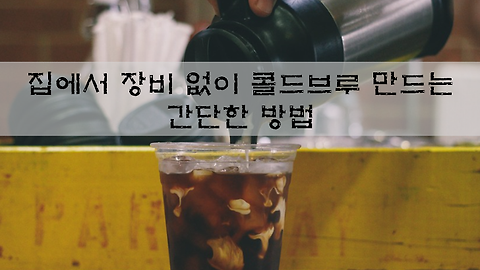How to choose and brew good Brazilian Cerrado coffee
- 행복한 커피
- 2018. 9. 28. 10:23
Greetings, this is CATCH MIND. Today the weather was amazing so, I had a short break sitting outside the café with a cup of coffee. The coffee I had was a blend of Brazilian and Ethiopian. Today I will share more about the Brazilian Cerrado coffee.
The Less Known Cerrado coffee
Coffee in Brazil region is the most produced coffee in the world. Plantation in the region perfectly automated, thus suitable for the mass production. Coffee production in Brazil evolved very quickly as it began with a large plantation with slaves. However, it is a fact that Brazilian coffee is not as popular as the African coffee. Ironically enough, the Brazilian coffee is characterized as not having too much character.
Cerrado and Mogiana are the two regions in Brazil famous with coffee. Regions' coffee is characterized by low acidity and nutty flavor. Brazilian coffee is often used for blending coffee because is tastes rather plain due to low acidity.
Brazil Cerrado is often used for blending because,
Firstly, it does not have a distinctive characteristic therefore, makes the overall taste of coffee better when it is blended with a strong coffee.
Secondly, it has low unit cost of production. The relatively low price makes it suitable coffee to use in large quantity. So, if you blend a strong coffee with Brazilian coffee as the base, you can control the price and taste at the same time, like killing two birds with one stone.
Lastly, it has stabilized supply and demand, and this brings a huge advantage. When creating the coffee blend, the base coffee must easily be available as it is used in huge amount. Due to such supply issues, Asian coffee is being used despite some drawbacks.
As mentioned earlier, Brazilian coffee does not have distinctive characteristics. If must describe the taste, it has "a mild acidity with strong nutty taste". The overall balance in taste does not seem perfect due to the heavy body and low acidity. The flavor is "nutty" like roasted peanuts. The taste may vary depending on the roasting level and brewing method, but, it would taste little too greasy when mixed with milk. This is the Q&A made from the frequently asked questions. Q: Doesn't the coffee taste better when you use Brazilian specialty coffee? A: That is correct. It would definitely taste better when you use the special coffee compare to the commercial coffee. However, this is not cost effective at all, even by taking consideration of the better taste. There is no big difference in price between African commercial coffee and Brazilian specialty coffee. Moreover, African commercial coffee is much superior in terms of the acidity and flavor balance. Q: How much Brazilian coffee should I add in when blending? A: Coffee is a product of personal preference so, there is no right or wrong answer to this question. You can blend the amount that you think it is ideal for you. But if the Brazilian coffee exceeds the certain ratio, you may only taste 'Brazilian' no matter what strong African coffee you mix. So please pay attention to the amount you are adding. Q: I have had Brazilian coffee that taste 'bitter' thou. A: Brazilian coffee does not have high density like African high-altitude coffee. Because the density of the coffee is low and not very hard, this influences the overall roasting process. If you adjust the drum temperature incorrectly during the process, you create an environment that can partially or totally burns the beans. And when the beans get burned, the bitter taste will be several times larger. Indeed, "bitterness is the monster that swallows all the other flavor." Q: Where can I buy the (Brazilian) coffee? A: This is the most commonly asked question. You may access all sorts of sales information easily and quickly on online. But, you must keep in mind that the question you must answer is how to differentiate and buy the right one rather than where you buy them. When you are buying Brazilian coffee, you must remember the followings. If the color is too light after roasting, the coffee taste might too greasy when mixed with milk. Also, there are quite a number of Brazilian coffee that is partially burned so you must make sure to check this.
Q: Then, how do I brew the coffee? A: This is a question that covers a broad range. Brewing method will be further discussed in next session but, for now let me explain briefly on the roasting and brewing method. When raosting the coffee, Due to the low density, Brazilian coffee absorbs heat easily during the roasting process. Moreover, it is vulnerable to be burned in the latter half of roasting process so, you need to carefully control the temperature throughout the process. When brewing the coffee, It is recommended not to purchase roasted beans in bright color. Try to buy those with darker color while avoiding the beans that have burnt at the tip. Just a little burn will make the taste quite bitter. While brewing, if the beans are roasted normally, it is good to brew until the coffee taste a little bitter. This might enhance the overall balance of the coffee flavor. Today we have discussed about Brazilian and Cerrado coffee. Next time, I will talk more about roasting, brewing and characteristics of coffee from different regions.
Thank you. Expression of Taste
Lastly,,,
'행복한 커피' 카테고리의 다른 글
| 아소부 콜드브루를 사용하여 맛있는 커피 쉽게 만들기 (0) | 2018.10.02 |
|---|---|
| 커피전문점 , 생과일 주스 전문점 위생점검 적발 결과 (0) | 2018.09.29 |
| Tips for buying good coffee beans (0) | 2018.09.26 |
| 코스타리카 커피 , 코스타리카 따라주 이야기 (0) | 2018.09.20 |
| 케냐 오타야 칭가퀸 , 특징과 로스팅 팁 (Kenya Othaya Chinga Queen) (0) | 2018.09.16 |
이 글을 공유하기













